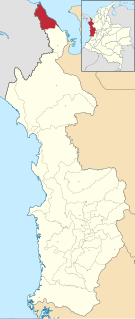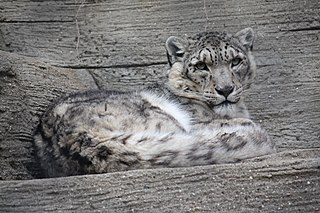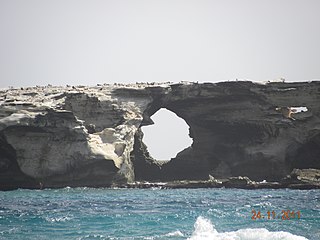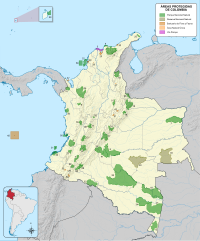
Playona Acandí Fauna and Flora Sanctuary is one of eleven new national parks in Colombia. It is the home of the Cana Turtle ( Dermochelys coriacea ). This park is on the (Uraba Gulf) Caribbean coast of the Department of Chocó. The Playon Playona Acandí Fauna and Flora Sanctuary is a strategic area for the survival of the hawksbill and leatherback turtles, the latter considered to be the world's largest sea turtle. [1]

Colombia, officially the Republic of Colombia, is a sovereign state largely situated in the northwest of South America, with territories in Central America. Colombia shares a border to the northwest with Panama, to the east with Venezuela and Brazil and to the south with Ecuador and Peru. It shares its maritime limits with Costa Rica, Nicaragua, Honduras, Jamaica, Haiti, and the Dominican Republic. Colombia is a unitary, constitutional republic comprising thirty-two departments, with the capital in Bogotá.

The leatherback sea turtle, sometimes called the lute turtle or leathery turtle or simply the luth, is the largest of all living turtles and is the fourth-heaviest modern reptile behind three crocodilians. It is the only living species in the genus Dermochelys and family Dermochelyidae. It can easily be differentiated from other modern sea turtles by its lack of a bony shell, hence the name. Instead, its carapace is covered by skin and oily flesh.

The Caribbean Sea is a sea of the Atlantic Ocean in the tropics of the Western Hemisphere. It is bounded by Mexico and Central America to the west and south west, to the north by the Greater Antilles starting with Cuba, to the east by the Lesser Antilles, and to the south by the north coast of South America.
With a total extension of 26,232 hectares, it is located in the Gulf of Darién on the Caribbean Coast, within the jurisdiction of the Municipality of Acandí, encompassing the beach and adjacent marine waters next to La Playona and some part of El Playón de Acandí. [1]

Acandí is a town in Colombia at the northern end of the department of Chocó in northwest of Colombia, bordering the Caribbean Sea. It is 366 km (227 mi) from the provincial capital, Quibdó. Its average temperature is 28 degrees Celsius (82 °F). It was founded around the year 1887, and it became a municipality in 1905, previously being part of Turbo. The name "Acandí" is a corruption of the indigenous word "Acanti", which means "River of Stone".
This zone is considered to be one of the main nesting sites of the leatherback sea turtle. Several authors and researchers belonging to the local Afro community (GILA group) state that each year over 200 turtles reach these beaches to lay their eggs. The Darién area and, particularly, the Acandí beaches, are equally important sites for the nesting of the hawksbill turtle in the Caribbean. [1]

Turtles are diapsids of the order Testudines characterized by a special bony or cartilaginous shell developed from their ribs and acting as a shield. "Turtle" may refer to the order as a whole or to fresh-water and sea-dwelling testudines. The order Testudines includes both extant (living) and extinct species. The earliest known members of this group date from 220 million years ago, making turtles one of the oldest reptile groups and a more ancient group than snakes or crocodilians. Of the 356 known species alive today, some are highly endangered.
The selection of the two beaches contributes directly to the protection of these two species which are critically endangered. Their migratory nature makes this area really important since all the local conservation efforts have a significant impact on the western Caribbean. Mark and recapture studies have shown that some of the females breeding in Colombia spend most of the year in Costa Rica and Mexico. In addition, this area contributes to the protection of other animals that are socially, economically and culturally important, including several shrimps and fish. [1]

Costa Rica, officially the Republic of Costa Rica, is a country in Central America, bordered by Nicaragua to the north, the Caribbean Sea to the northeast, Panama to the southeast, the Pacific Ocean to the southwest, and Ecuador to the south of Cocos Island. It has a population of around 5 million in a land area of 51,060 square kilometers. An estimated 333,980 people live in the capital and largest city, San José with around 2 million people in the surrounding metropolitan area.

Mexico, officially the United Mexican States, is a country in the southern portion of North America. It is bordered to the north by the United States; to the south and west by the Pacific Ocean; to the southeast by Guatemala, Belize, and the Caribbean Sea; and to the east by the Gulf of Mexico. Covering almost 2,000,000 square kilometres (770,000 sq mi), the nation is the fifth largest country in the Americas by total area and the 13th largest independent state in the world. With an estimated population of over 120 million people, the country is the tenth most populous state and the most populous Spanish-speaking state in the world, while being the second most populous nation in Latin America after Brazil. Mexico is a federation comprising 31 states and Mexico City, a special federal entity that is also the capital city and its most populous city. Other metropolises in the state include Guadalajara, Monterrey, Puebla, Toluca, Tijuana and León.

The term shrimp is used to refer to some decapod crustaceans, although the exact animals covered can vary. Used broadly, shrimp may cover any of the groups with elongated bodies and a primarily swimming mode of locomotion – most commonly Caridea and Dendrobranchiata. In some fields, however, the term is used more narrowly and may be restricted to Caridea, to smaller species of either group or to only the marine species. Under the broader definition, shrimp may be synonymous with prawn, covering stalk-eyed swimming crustaceans with long narrow muscular tails (abdomens), long whiskers (antennae), and slender legs. Any small crustacean which resembles a shrimp tends to be called one. They swim forward by paddling with swimmerets on the underside of their abdomens, although their escape response is typically repeated flicks with the tail driving them backwards very quickly. Crabs and lobsters have strong walking legs, whereas shrimp have thin, fragile legs which they use primarily for perching.
Local communities adjacent to La Playona and Playón de Acandí consider the leatherback turtle a symbol and part of the region's cultural, touristic and ecological heritage. For instance, on Easter 1993 the "Leatherback Turtle Festival" began as a strategy to create awareness of the importance of this species. The area also contributes to maintain marine biodiversity and the artisanal fisheries of Urabá and Darién. More than 80 species make up the fishing resources for the community of Acandí. [1]

The Gulf of Urabá is a gulf on the northern coast of Colombia. It is part of the Caribbean Sea. It is a long, wide inlet located on the coast of Colombia, close to the connection of the continent to the Isthmus of Panama. The town of Turbo, Colombia, lies at the mid eastern side naturally sheltered by the Turbo Bay part of the Gulf. The Atrato River flows into the Gulf of Urabá.

The Darién Gap is a break in the Pan-American Highway consisting of a large swath of undeveloped swampland and forest within Panama's Darién Province in Central America and the northern portion of Colombia's Chocó Department in South America. The gap begins in Yaviza, Panama and ends in Turbo, Colombia, and is 106 km long. Roadbuilding through this area is expensive and the environmental cost is high. Political consensus in favor of road construction has not emerged.
Since the beginning, the declaration of this new protected area was sought by the Afro Communities Councils of the Tolo River Basin and the Southern Coastal Zone (Cocomasur); the Acandí Seco River Basin, El Cedro and El Juancho (Cocomaseco) and the Acandí River and the Northern Coastal Zone (Cocomanorte). It was also supported, through technical collaboration by WWF Colombia during almost 10 years. In order to properly manage the planning of the Sanctuary, a coordination mechanism will be established among the three community councils and National Parks to achieve the conservation goals. [1]

The World Wide Fund for Nature (WWF) is an international non-governmental organization founded in 1961, working in the field of the wilderness preservation, and the reduction of human impact on the environment. It was formerly named the World Wildlife Fund, which remains its official name in Canada and the United States.













